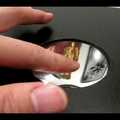
„A 33-as számú kutatás egy olyan komplex tett volt, ami a művész érzékenységét az űrrepülés technológiájával kapcsolta össze. 1998. április 4.-én felszálltam egy NASA KC135 turbojet-tel a Mexikói-öböl fölött Houston Johnson Space Centeréből, és az a félelmetes érzést kerített a hatalmába, hogy tudományos kutatásként hozok létre művészetet egy mikro gravitációs környezetben.
A célkitűzéseim egyszerűek: kiküszöbölni a szerkezeti alátámasztást -- a vászon — mialatt a festmény készül, lebeg a levegőben, a testemet beborítja a kompozíció. E technikával és a mikro gravitációval szándékozom hozzájárulni az organikus fejlődéshez, ezzel a kinetikus „lebegő festéssel”, spontaneitással komponálok a cél érdekében.” Vallja az amerikai művész.
 „Research Project Number 33 was an interdisciplinary action that bridged the sensibility of the artist with the technology of space flight. On 4 April 1998, I flew aboard a NASA KC135 turbojet over the Gulf of Mexico from Houston’s Johnson Space Center and experienced the awe-inspiring sensation of creating art in a microgravity environment as scientific research.
„Research Project Number 33 was an interdisciplinary action that bridged the sensibility of the artist with the technology of space flight. On 4 April 1998, I flew aboard a NASA KC135 turbojet over the Gulf of Mexico from Houston’s Johnson Space Center and experienced the awe-inspiring sensation of creating art in a microgravity environment as scientific research.
My intention was simple: to eliminate the structural support—the canvas—while creating paintings floating in mid-air, with my body enveloped in the composition. I intended for technology and microgravity to contribute to the organic development of these kinetic “drift paintings,” with spontaneity and serendipity orchestrating the results”
/NOTE: The text presented in this section was written by Frank Pietronigro and published in the MIT Press publication Leonardo 33, No. 3, pp. 169–177, 2000./
.gif)
.gif)

 http://www.pietronigro.com/space/movies.htm
http://www.pietronigro.com/space/movies.htm



